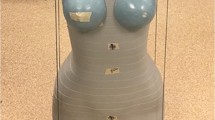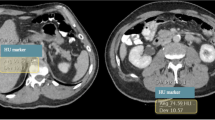Abstract
Background
Iterative reconstruction technique has been proposed as a means of reducing patient radiation dose in pediatric CT. Yet, the effect of such reductions on diagnostic accuracy has not been thoroughly evaluated.
Objective
This study compares accuracy of diagnosing pediatric acute appendicitis using contrast-enhanced abdominopelvic CT scans performed with traditional pediatric weight-based protocols and filtered back projection reconstruction vs. a filtered back projection/iterative reconstruction technique blend with reduced volume CT dose index (CTDIvol).
Materials and methods
Results of pediatric contrast-enhanced abdominopelvic CT scans done for pain and/or suspected appendicitis were reviewed in two groups: A, 192 scans performed with the hospital’s established weight-based CT protocols and filtered back projection reconstruction; B, 194 scans performed with iterative reconstruction technique and reduced CTDIvol. Reduced CTDIvol was achieved primarily by reductions in effective tube current-time product (mAseff) and tube peak kilovoltage (kVp). CT interpretation was correlated with clinical follow-up and/or surgical pathology. CTDIvol, size-specific dose estimates (SSDE) and performance characteristics of the two CT techniques were then compared.
Results
Between groups A and B, mean CTDIvol was reduced by 45%, and mean SSDE was reduced by 46%. Sensitivity, specificity and diagnostic accuracy were 96%, 97% and 96% in group A vs. 100%, 99% and 99% in group B.
Conclusion
Accuracy in diagnosing pediatric acute appendicitis was maintained in contrast-enhanced abdominopelvic CT scans that incorporated iterative reconstruction technique, despite reductions in mean CTDIvol and SSDE by nearly half as compared to the hospital’s traditional weight-based protocols.

Similar content being viewed by others
References
Callahan MJ, Rodriguez DP, Taylor GA (2002) CT of appendicitis in children. Radiology 224:325–332
York D, Smith A, Phillips JD et al (2005) The influence of advanced radiographic imaging on the treatment of pediatric appendicitis. J Pediatr Surg 40:1908–1911
Martin AE, Vollman D, Adler B et al (2004) CT scans may not reduce the negative appendectomy rate in children. J Pediatr Surg 39:886–890, discussion 890
Doria AS, Moineddin R, Kellenberger CJ et al (2006) US or CT for diagnosis of appendicitis in children and adults? a meta-analysis. Radiology 241:83–94
Taylor GA, Wesson DE (2013) Acute appendicitis in children: diagnostic imaging. In: Singer JI, Wiley JF (eds) UpToDate®. Wolters Kluwer Health, Philadelphia, PA http://www.uptodate.com. Accessed 18 December 2013
Krishnamoorthi R, Ramarajan N, Wang NE et al (2011) Effectiveness of a staged US and CT protocol for the diagnosis of pediatric appendicitis: reducing radiation exposure in the age of ALARA. Radiology 259:231–239
Hopkins KL, Pettersson DR, Koudelka CW et al (2013) Size-appropriate radiation doses in pediatric body CT: a study of regional community adoption in the United States. Pediatr Radiol 43:1128–1135
Koninklijke Philips Electronics NV (2011) iDose4 iterative reconstruction technique: breakthrough in image quality and dose reduction with the 4th generation of reconstruction. http://www.healthcare.philips.com/pwc_hc/main/shared/Assets/Documents/ct/idose_white_paper_452296267841.pdf. Accessed 3 January 2013
Willemink MJ, de Jong PA, Leiner T et al (2013) Iterative reconstruction techniques for computed tomography. Part I: technical principles. Eur Radiol 23:1623–1631
Mahesh M (2011) Advances in CT technology and application to pediatric imaging. Pediatr Radiol 41:S493–S497
Siegel MJ, Schmidt B, Bradley D et al (2004) Radiation dose and image quality in pediatric CT: effect of technical factors and phantom size and shape. Radiology 233:515–522
Karmazyn B, Liang Y, Klahr P et al (2013) Effect of tube voltage on CT noise levels in different phantom sizes. AJR Am J Roentgenol 200:1001–1005
Goske MJ, Strauss KJ, Coombs LP et al (2013) Diagnostic reference ranges for pediatric abdominal CT. Radiology 268:208–218
Strauss KJ, Goske MJ (2011) Estimated pediatric radiation dose during CT. Pediatr Radiol 41:S472–S482
American Association of Physicists in Medicine (2011) Size specific dose estimates (SSDE) in pediatric and adult body CT examinations (Report No. 204). American Association of Physicists in Medicine, College Park
Matsuno WC, Anaya R, Tay ET et al (2012) Computed tomographic scan diagnosis of appendicitis in children by pediatric and adult radiologists. Pediatr Emerg Care 28:265–267
Garcia K, Hernanz-Schulman M, Bennett DL et al (2009) Suspected appendicitis in children: diagnostic importance of normal abdominopelvic CT findings with nonvisualized appendix. Radiology 250:531–537
Griner PF, Mayewski RJ, Mushlin AI et al (1981) Selection and interpretation of diagnostic tests and procedures. Principles and applications. Ann Intern Med 94:557–592
Acknowledgments
Dr. Didier is supported by National Institute of Biomedical Imaging and Bioengineering grant #1R25EB016671.
Conflicts of interest
None
Author information
Authors and Affiliations
Corresponding author
Rights and permissions
About this article
Cite this article
Didier, R.A., Vajtai, P.L. & Hopkins, K.L. Iterative reconstruction technique with reduced volume CT dose index: diagnostic accuracy in pediatric acute appendicitis. Pediatr Radiol 45, 181–187 (2015). https://doi.org/10.1007/s00247-014-3109-7
Received:
Revised:
Accepted:
Published:
Issue Date:
DOI: https://doi.org/10.1007/s00247-014-3109-7




